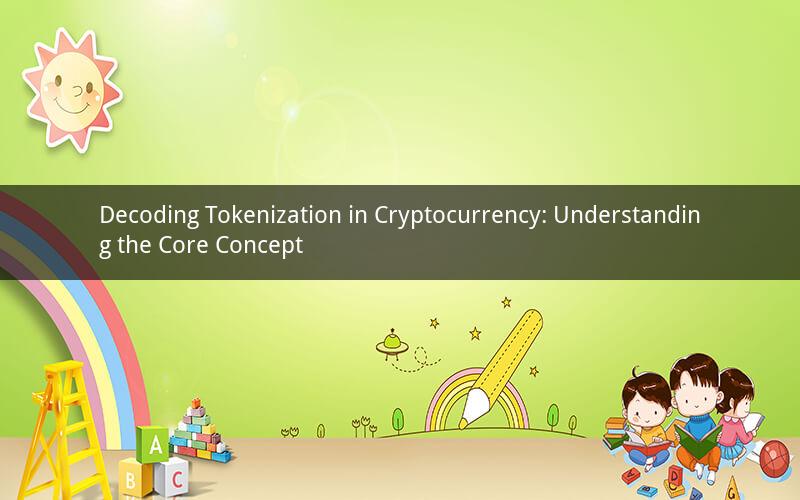
Introduction:
In the ever-evolving world of cryptocurrencies, the term "tokenization" has become increasingly prevalent. But what exactly is tokenization, and how does it shape the landscape of digital currencies? This article delves into the concept of tokenization in cryptocurrency, providing a comprehensive understanding of its significance and applications.
What is Tokenization in Cryptocurrency?
Tokenization is the process of converting real-world assets, such as property, stocks, or bonds, into digital tokens on a blockchain platform. These tokens represent ownership or participation in the underlying asset and can be transferred, traded, or used as a medium of exchange. In the context of cryptocurrencies, tokenization refers to the creation and management of digital tokens that are native to a particular blockchain network.
How Does Tokenization Work?
The process of tokenization involves several steps:
1. Asset Identification: The first step is to identify the real-world asset that will be tokenized. This could be a physical asset, such as property, or a financial asset, such as a stock or bond.
2. Token Creation: Once the asset is identified, a digital token is created to represent ownership or participation in that asset. The token is usually issued on a blockchain platform, which ensures transparency, security, and immutability.
3. Asset Representation: The token carries information about the underlying asset, such as the asset's value, ownership details, and any other relevant data. This information is stored on the blockchain, making it accessible to all participants in the network.
4. Transfer and Trading: Tokens can be transferred from one party to another, representing the transfer of ownership or participation in the underlying asset. They can also be traded on decentralized exchanges, allowing for liquidity and marketability.
5. Asset Redemption: When the token is no longer needed, it can be redeemed for the underlying asset. This process involves returning the token to the issuer and receiving the corresponding real-world asset.
Benefits of Tokenization in Cryptocurrency
Tokenization offers several benefits in the cryptocurrency space:
1. Enhanced Accessibility: Tokenization allows for the democratization of assets, making them accessible to a wider audience. Anyone with internet access can participate in tokenized markets, regardless of geographical or financial barriers.
2. Increased Liquidity: By tokenizing assets, liquidity is improved, as tokens can be easily bought, sold, or traded on decentralized exchanges. This liquidity enables investors to enter and exit positions quickly and efficiently.
3. Cost Reduction: Tokenization can significantly reduce transaction costs associated with traditional financial systems. By eliminating intermediaries, such as brokers or banks, tokenized assets can be transferred and managed more cost-effectively.
4. Improved Security: Blockchain technology provides a secure and transparent platform for tokenization. The decentralized nature of the blockchain ensures that transactions are immutable and tamper-proof, reducing the risk of fraud and theft.
5. Streamlined Processes: Tokenization simplifies various processes, such as asset transfer, record-keeping, and compliance. This streamlined approach can lead to increased efficiency and reduced administrative burdens.
Applications of Tokenization in Cryptocurrency
Tokenization has various applications in the cryptocurrency space:
1. Security Tokens: Security tokens represent ownership or participation in a company or investment opportunity. They provide investors with access to traditional asset classes, such as stocks, bonds, or real estate, in a digital format.
2. Utility Tokens: Utility tokens are used within a specific ecosystem to access services or products. They can be used for transactions, voting, or other functions within the ecosystem.
3. Asset Tokens: Asset tokens represent ownership or participation in real-world assets, such as property, commodities, or intellectual property. They enable fractional ownership and increased liquidity for these assets.
4. Loyalty Tokens: Loyalty tokens are used to reward customers for their loyalty to a brand or company. These tokens can be redeemed for discounts, rewards, or other benefits.
5. Governance Tokens: Governance tokens provide holders with voting rights and influence over the direction of a blockchain project or organization. They enable decentralized decision-making and community-driven governance.
Frequently Asked Questions (FAQs)
1. Q: What is the difference between a token and a cryptocurrency?
A: A token is a digital asset that represents ownership or participation in an underlying asset or service, while a cryptocurrency is a digital currency that operates independently of any real-world asset.
2. Q: Can tokenization be used for any type of asset?
A: Yes, tokenization can be used for various types of assets, including physical assets, financial assets, and intellectual property.
3. Q: Is tokenization secure?
A: Tokenization is generally secure, as it is based on blockchain technology, which ensures transparency, immutability, and security. However, the security of a tokenized asset also depends on the underlying platform and its implementation.
4. Q: Can tokenization replace traditional financial systems?
A: Tokenization can complement traditional financial systems by providing enhanced accessibility, liquidity, and efficiency. However, it is unlikely to completely replace traditional systems in the near future.
5. Q: What are the regulatory challenges of tokenization?
A: Tokenization poses regulatory challenges, as it intersects with various financial and legal frameworks. Compliance with applicable regulations is crucial to ensure the legality and sustainability of tokenized assets.